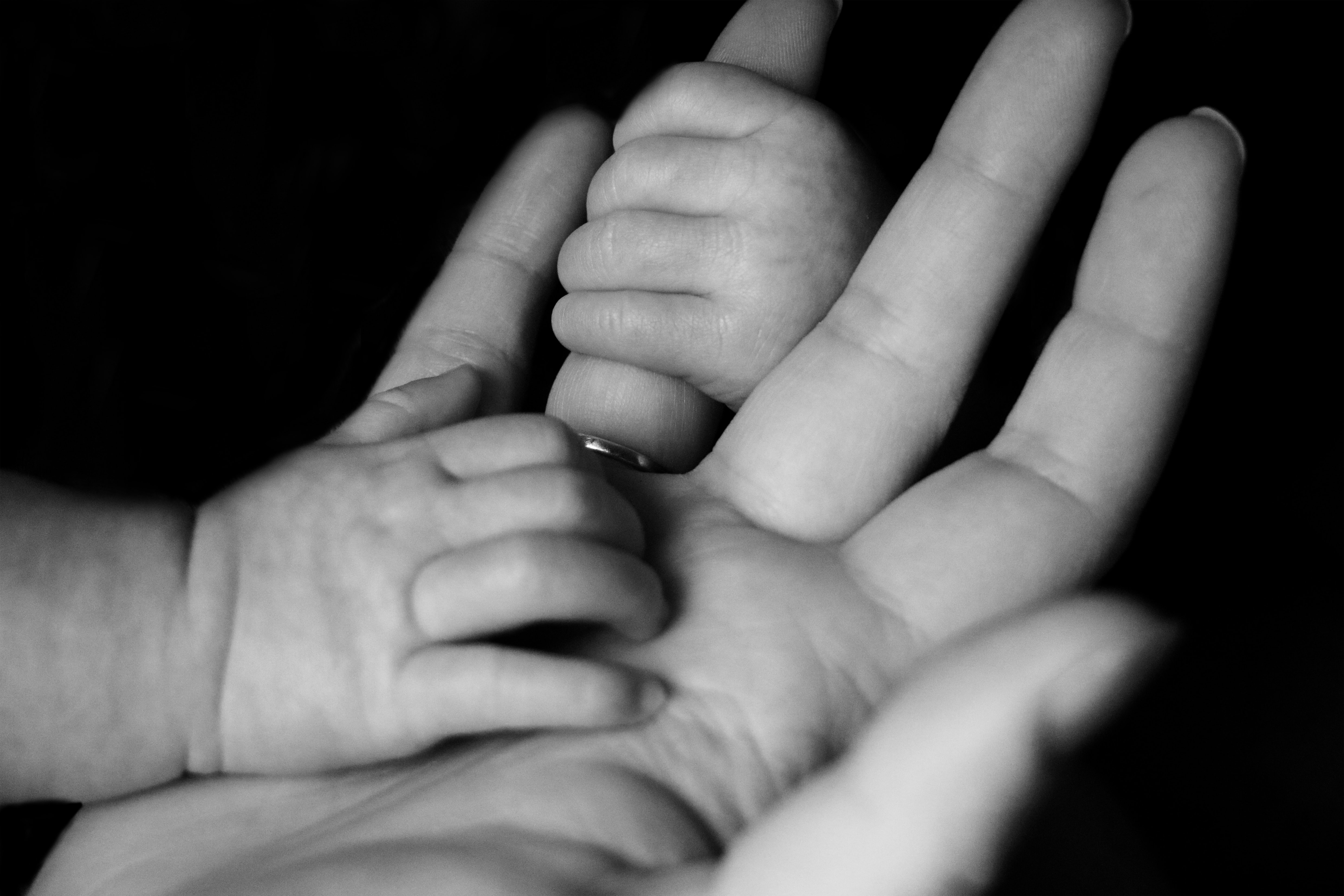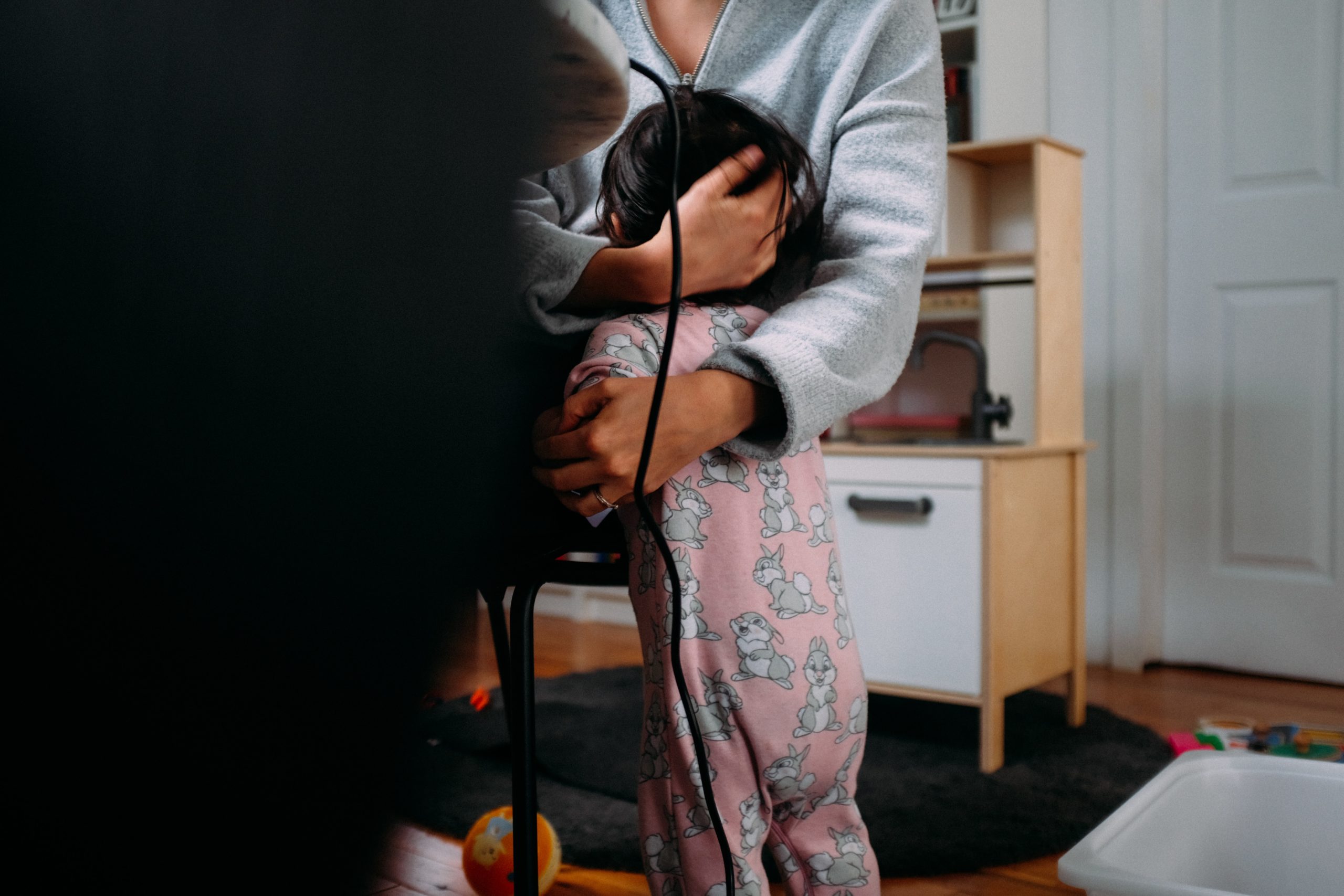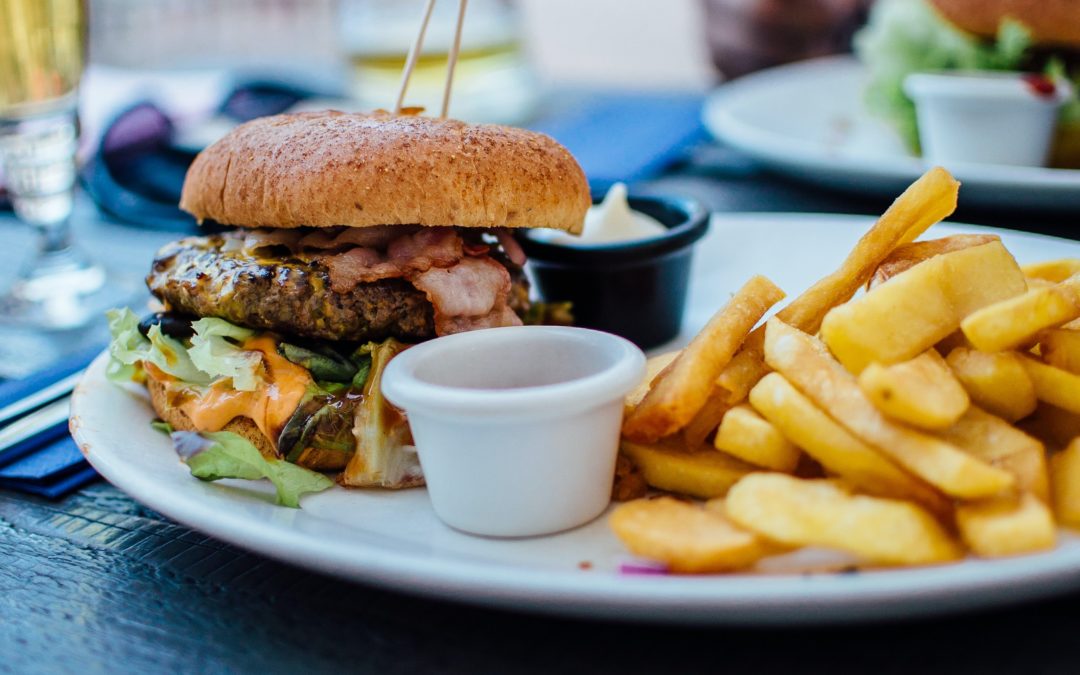
by rossanahead | Nov 24, 2011 | children, family, grandparenting, Jing Lejano, parenting, woman
By Jing Lejano
Baby S wasn’t feeling well the other day. She woke up with a fever and slept the entire morning. When I visited her in the afternoon, all cuddled up in bed with a blanket, she held my arms and said, “Lula, sit.” And so, despite the fact that I was in the middle of deadlines, I sat with Baby S and eventually cuddled up to her until she fell asleep.
A couple of hours later, just before sunset, Baby S was feeling much better. She was able to eat, watch a little TV, and play with my son K. But when it was time for bed, she didn’t want to leave our house. She insisted on going upstairs with Lula. And so we climbed up the stairs to my room, she with her milk and her “pampin” (her nappies, which is her security blanket of sorts) and me with my book and a glass of water.
We lay on the bed together, she with her arms around a stuffed toy tiger and me with my arms around her. We were just in bed, enjoying each other’s silent company.
I’ve done this very thing, maybe a million times before—with my daughter E, when her playmate pushed her on the balustrade and had to have a head wound stitched; with my son F, when he had another bout with bronchitis; with my son S, when he was generous enough to give his vacation slot to his younger brother; and with my youngest son K, when he had another one of his scary dreams.
When my daughter E just had Baby S, I remember telling her that I don’t want to do anymore of the taking-care-of-baby stuff. I don’t want to change the diapers. I don’t want to play peek-a-boo. And I don’t want to take care of another sick baby.
Well, guess what? I’ve been doing exactly that. I can’t help it! I’m a mom. I’m a Lula. And I just wouldn’t be true to myself if I don’t cuddle up to dear Baby S. Love is love.
Photo by Liv Bruce on Unsplash

by rossanahead | Nov 19, 2011 | Ruth M. Floresca, woman
By Ruth Manimtim-Floresca
If you are familiar with The Corrs, you probably know their hit song where the lyrics go, “And it really doesn’t matter if we don’t eat, and it really doesn’t matter if we never sleep … ‘cause we are so young now, we are so young, so young, now …”
I could very well identify with those sentiments. There were a lot of times during my college days and after graduation when I also felt invulnerable. I could spend a whole night talking with friends or walking around the campus under the pouring rain without getting sick. Back then, I could push myself hard and bounce back after just a few hours of rest.
Not anymore. Lately, I’ve been getting a lot of protest from my bones, my muscles, and even my skin! The other day, I interviewed the CEO of a company that carries beauty and wellness products. There, I was offered to have my facial skin analyzed using a high-tech machine that takes photos of one’s face in high definition.
The beauty consultant showed me the pictures one by one using an LED screen. I found myself squirming and grimacing as she started zooming in on each problem area. She said my skin is dehydrated, I have slightly enlarged pores, there are already fine wrinkles around my eyes, and I have lots of pigmentation. She advised me how to prevent the conditions from getting worse and, for the first time, I really paid attention. It’s not every day I get to see all my skin’s imperfections flashed larger than life on a computer monitor! And it was hard not to wonder how bad things could get if I don’t take care of my skin while it can still be saved.
A lot of women won’t acknowledge it but, deep down, we are vain. Admit it; many of us avoid revealing our age when the number goes past 25. We also show a lot of interest when new health and beauty products come out promising to make us look more youthful and give them test runs as much as our budget allows. That’s something most men can’t comprehend but which we, females, understand well. After all, knowing we look presentable draws out that inner confidence that makes our steps lighter and our heads held higher.
Now, I’m trying to pay more attention to what I eat, what activities I engage in, and what products I use on my body. I’m not actually searching for the fountain of youth but I do want to stay healthy inside and out because I’d like to remain strong as long as possible and have many years more with my family. I believe those are good enough reasons to really start living, and not just thinking about, a healthier lifestyle.
Photo by David Hofmann on Unsplash

by rossanahead | Nov 17, 2011 | family, Gina Abuyuan, parenting, travel, woman
By Gina Abuyuan
Writer and editor Alya Honasan takes pride in her annual solo getaways. She’s a diver, and for about a decade now, she embarks on dive trips—Palawan, Palau, Australia—by herself. It’s invigorating, she says. And the feeling of freedom and independence is like no other.
When I was single, I never had the courage to take off the way Alya does, even though I daydreamed about it. Hitch-hiking across the Philippines, setting up a tent alone on a beach, discovering Sagada on my own–I thought about all doing those things, but never had the balls to carry them out. I stand barely five feet, a tad gullible, and sometimes too shy to speak out in case I offend someone (although people close to me are sure to contest that)—not an ideal formula for a solo female traveller.
These days, though—older, tougher, not afraid to tell someone off–I can pretty much hold my own. I’ve travelled to Camarines Norte and Palawan alone, downed drinks in bars alone, and roamed the backstreets of Chiang Mai alone. The latest solo trip I took was the one to Marabut, Samar, for a much needed break after a weighty assignment interviewing farmers affected by climate change in Southern Leyte.
I chose Caluwayan Resort, a three-star resort with four villas and two open cottages fronting the beach. Since I didn’t have the budget to rent a villa (P5,000 a night), I opted for the open cottage—and when I say open, I mean open. It’s a gazebo walled-in by a white canvas tied to the posts. The “door” is a double layered curtain of canvas and gauze. There’s a double bed and a side table. It may sound bare, but it was actually quite comfortable. I felt like I was sleeping in my own room, with the bonus of the sound of waves and natural breeze. Magical.
That said, there are certain things you need to remember if you choose to go on a solo holiday. Here are the most important:
- Make sure your kids, husband or partner, or a close friend knows where you’re going. Show them the web site and give them the contact details. Tell them when you plan to leave, and your ETA back in your hometown.
- Keep your mobile phone on (even if it’s on silent) all the time. If the signal’s wonky (as it is in Samar), inform them so they don’t worry.
- Bring medication if you’ve got a condition that calls for it. I’m asthmatic, so I bring at least two inhalers with me, plus anti-histamines. Inform the restaurant or the cook of any allergies, so they don’t mix any crab or shrimp or lobster (in my case, that is) in your food.
- Bring along a self-defense weapon and know how to use it. This can be a pepper spray, a taser, or a small knife.
- Don’t attract attention. It’s inevitable that a man/men will want to chat you up or be curious on your solo status. I choose not to make eye contact if I sense a man is trying to catch my attention, and I clothe myself in a “leave me alone” aura. I also make it a point to let the receptionist or waiter or boatman know that I’m married (or at least, partnered) and have three children. This is my way of saying, “Yes, people will look for me if I disappear.”
- Don’t get inebriated. No explanation needed.
Some moms may think that this is a little extreme—alone time away, hundreds of kilometers from home, when an hour at the spa can do the trick. There comes certain instances, though, certain valleys in one’s psychological, emotional, and physical health patterns, that can only be cured by a literal change of pace and scenery. Like Alya’s—and if you are so inclined—you can treat yourself to a solo holiday once a year. Let go of the guilt, plan it well, involve the help and understanding of your partner, support group, and kids. Take it from me: you will come back renewed and refreshed. You won’t regret it, and—seeing what good it did Mom–neither will your partner and children.
Photo by averie woodard on Unsplash

by rossanahead | Nov 12, 2011 | children, family, parenting, Rossana Llenado, woman
By Rossana L. Llenado
Are you a helicopter parent? Do you constantly hover over your children, fussing over their every move? Or are you a free-range parent? Do you allow your children to go off on their own whether it’s meeting up with friends at the mall or doing their schoolwork?
The other week, I attended a seminar at the Center for Family Ministries (CEFAM) at Ateneo de Manila University, one of the Philippines’ leading universities. During the seminar, there was a discussion of the various parenting styles employed by Filipinos. And I tell you that it was definitely an eye-opener.
Through the years, we’ve heard of different terms to describe different parenting styles. We’ve heard of the child-centered non-confrontational parenting, where the child is the center of the universe and the word “no” seems absent from the parents’ vocabulary. There is attachment parenting, where parents attempt to form intimate bonds with their children from birth. Some of the ideas that attachment parents espouse include breastfeeding, baby wearing, and sleeping close to their children or sometimes, co-sleeping. Positive parenting believes in the power of positive reinforcement, saying “do” instead of “don’t” and praising children for good behavior. And then there are those who choose to be uninvolved in their children’s affairs, relegating their parental duties and responsibilities to their own parents or to their kids’ school. Most recently, we met the Tiger Mom, who pushed her children to do their best through a stringent set of rules and schedules.
Basic Framework
I suppose that there are as many parenting styles as there are parents. But really, all these parenting styles originate from three basic frameworks, as described by development psychologist Diana Baumrind. These are the authoritarian, the authoritative, and the permissive.
The authoritarian parent is very familiar to those who grew up in the ‘60s and ‘70s. This is the classic “because I said so” type of parent. He has a strict set of rules that his children must obey no matter what. Rules are set in stone with no room for discussion. And not following those rules would lead to serious consequences, often involving a bit of spanking or some serious grounding.
The authoritarian parent sees the world in black and white. For him, there are no gray areas. Picture the typical patriarch oftentimes played by Ronaldo Valdez in countless Filipino movies and you’ll know what I’m talking about. Control is his main objective. He believes that if his children follow the rules, then they would grow up into good individuals.
The authoritarian parent is often seen as cold and unfeeling.
The authoritative parent is also fond of rules and limits, but he makes sure to explain why those restrictions came about in the first place. Children have more wiggle room because they are given the freedom to make their own choices—just so long as they stay within socially acceptable parameters of good behavior, of course.
But make no mistake about it, the authoritative parent has no qualms about saying the word “no.” However, he tells his children the many reasons behind his “no.” For him, giving a valid explanation will enable his children to understand and respect his decision. He does not want any rebels in his family.
The authoritative parent is perceived as warm toward his children but firm about enforcing rules and structure into their lives.
The permissive parent puts his children’s wants and needs first and foremost. Rules are thrown out the window. What’s important for the permissive parent is for his children to get exactly what they want.
The absence of rules gives children a sense of freedom, which unfortunately is something that they cannot handle at that young age. While the permissive parent is known to be very loving, he is often perceived as not being dependable. That’s because his decisions are not based on his own beliefs, but on what his children want, which can sometimes be erratic.
Most parents use a combination of these three parenting styles. Some are more authoritarian when their kids are young and then go on to be more authoritative as their kids get older.
At dinner the other night, I asked my kids to describe my parenting style. At first, they couldn’t decide. Actually, they sort of got into a big argument about it. One of my kids said that I’m too controlling, the other countered that I actually let them do whatever it is that they like. Another said that I don’t spend enough time with them, which was opposed by another who observed that I spend all my non-working hours with them. It was fun—and enlightening—to see them dissect my every move. Actually, it never occurred to me that they would be so observant about my comings and goings.
When I showed them reference materials from the seminar, they realized I was more authoritative than anything else. They realized too that I always give my reasons when I impose rules, and that seemed to go very well with them.
The Need to Define Ourselves
Whenever a new parenting term comes up, I’ve noticed, it is always met with much nitpicking and sometimes furious debates. We worry that we’re becoming helicopter parents, so we try to loosen our leash a little. We would secretly love to be Tiger Moms, but are afraid of what our neighbors would say.
We like putting labels and defining our styles because we want to put some logic into this whole parenting thing. Raising a happy, healthy, and confident child is probably one of the most difficult jobs in the universe. But of all the jobs we do in this world, it is the one thing that we want to do right.
This essay was first published in Asian Journal.
Photo by Charles Deluvio on Unsplash

by rossanahead | Nov 10, 2011 | children, parenting, woman
By Romelda C. Ascutia
In our neighborhood, there are a couple of small eateries that I regard as lifesavers.
The first one makes my mornings go so much easier. On days when I am pressed for time, I just head over to this old man’s food stall and buy takeout. My favorite is his arroz caldo, the best I’ve tasted so far. I know the secret to its great homey taste. If you get there really early—around 5:30 a.m.—when he has just placed the vat of piping-hot porridge on the display table, you can still spy the huge cow’s bone and the floating bits of beef lard that make it extra flavorful.
I buy different kinds of breakfast, so my family can choose. There’s spaghetti, soup, pancit, and champorado. My kids like the soup, which I serve with scoops of powdered milk stirred in. When they hanker for arroz caldo, I buy it with an extra order of hard-boiled eggs for added protein.
And it’s so affordable that your wallet never becomes anorexic even if you buy every day. No wonder the old man’s nameless eatery is a hit among people who know about it—busy moms like me, employees who bring their breakfast to their office, students who are on a tight budget. It’s important to go to his stall before 7 a.m. or the food will be almost gone. By 9 a.m., his stall is closed for the day.
Lately, after several years, the old man has decided to expand his business. He now serves lunch fare and has installed tables for diners. His move has widened my options as well. I work from the house, and since I am alone from around 9 a.m. I normally just reheat leftovers from last night’s dinner. Now that my favorite eatery serves lunch, a second trip puts more variety to my table.
In the afternoon, I go to another eatery of sorts, an ambulant one that roams our neighborhood. On plastic-covered trays are banana cue, turon, palitaw, lumpiang prito, pancit or spaghetti, itlog ng pugo, and what I always look for, ginataang bilu-bilo that the vendor alternates with ginataang mais or ginataang monggo every so often. The roving food stall saves me cooking time and effort especially when I have tight deadlines, and gives me a welcome break from work. When the children come home, their afternoon snack is laid out on the table. Another day saved!
Photo by Robin Stickel on Unsplash
by rossanahead | Nov 6, 2011 | children, home, parenting, woman
By Julie Javellana-Santos
For me, the Christmas season officially began when I found myself waking up at dawn and groping around for a blanket. The mornings had suddenly grown cooler. Where before I kicked off all covers, it was all I could do to snuggle into a comforter a few days ago. Needless to say, it took a monumental amount of will to get up and start getting dressed for the day.
For my sisters, the Christmas season began when the malls started playing Christmas carols last September. My sisters call me “Scrooge” because among all of us (we are five), I do not look at the holiday season as vacation time, but rather as a “stressful” time.
When the word Christmas is mentioned, images of endless traffic jams and malls packed with shoppers immediately enter my mind. This particularly affects me because of the many gifts I have to get. Since I was a little girl, my parents had Christmas gifts for everyone around them—the household help, our numerous aunts, uncles, and cousins in the province, and so on and so forth, and this is a tradition I want my own daughters to carry on.
Having been in media most of my life, I always found myself wrapping presents up to the last minute as vacation leave time could not be obtained to get those gifts and then wrap them. Being in media is stressful in itself as there are no holidays, no days off. One is always on call. Perhaps that is why the idea of Christmas as a time to enjoy is all but alien to me.
When I was a freelancer and master of my own time, I could do all this and the decorating as well. I had all the time in the world to scout for new decorations, and to refurbish my old stuff.
But perhaps it is time to pass on that task to my daughters. So this year I will leave them to do the decorating and the figuring out which of our Christmas decorations need to be changed and which do not. I will also leave them to do the shopping for gifts, the wrapping, and the distributing, all with the objective of giving me more time to enjoy myself this season–for a change.
Now if only something could be done about the Christmas traffic . . .





